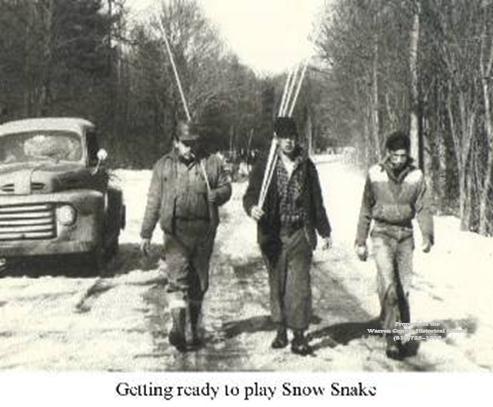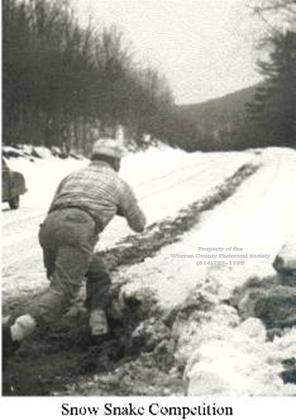SNOWSNAKE
The game of Snowsnake is exclusively a traditional Woodland Indian winter sport. The snowsnake, when hurled along a track, may travel up to a mile if conditions are ideal. Years ago, the snakes were thrown along roadways, or over frozen rivers, along fence rows or wherever there was an accumulation of snow. The track was introduced to the game about the turn of the century.
travel up to a mile if conditions are ideal. Years ago, the snakes were thrown along roadways, or over frozen rivers, along fence rows or wherever there was an accumulation of snow. The track was introduced to the game about the turn of the century.
As long as there is snow, the game of snowsnake can be played. Very seldom is a tournament cancelled due to weather. Weather factors can prove to be an added challenge to the skill of the snowsnake competitor.
The skill of the snowsnake maker, who is also called a "shiner," is extremely influential in producing a winning snowsnake. But equally important is how the snowsnake is selected and prepared for each game once it is made. It is important to note that each process taken to prepare the snake may be repeated as many times as desired, depending on the specifications of the individual.
There are two types of snakes; the short snakes called "Mudcats" are approximately three feet long, and the "Long Snakes" are approximately seven feet long.

Selecting the Wood
The maker selects a young tree of hickory, ironwood, hard maple, or juneberry, as these types of hardwood are more adaptable to the manufacturing of a snowsnake; other kinds of hardwood with a fine grain can also be used. The type of snowsnake and the amount obtained are determined by the size of the tree and the straightness of the grain. The diameter of the tree may be from 8 to 10 inches. Depending on each maker's personal technique, the wood may be left whole for one year with the ends greased, split into sections to dry, or soaked in linseed oil for a period of six months to a year. However, all snakes are not always soaked in oil. It may not be soaked until the snake has been completed and has not run satisfactorily under a variety of snow conditions. The snake may then be soaked in oil and be referred to as an "oil snake," which is water repellent and heavier than usual. The snake would then be used for wet snow conditions, although it could also be used under other weather conditions depending upon the ability of the individual shiner.
Shaping the Snowsnake and Tip
When making the snowsnakes, the log is split and each section is cut into 1 3/4" squared lengths of approximately three feet or seven feet. The squared stick is worked down with a wood plane, rasp, spoke shave, or drawn knife to obtain the desired shape. The wood is worked along the grain and has to be dry when shaping.
 Steel wool or a piece of glass is used to polish the snake, giving it a smooth surface. The snake is then washed in clear water and, since wood is porous and expands when wet, the splinters are forced to stand out. The snake is dried and sanded again with fine steel wool or sandpaper. As this process is done repeatedly, the snake will expand less and less, making it more water resistant each time.
Steel wool or a piece of glass is used to polish the snake, giving it a smooth surface. The snake is then washed in clear water and, since wood is porous and expands when wet, the splinters are forced to stand out. The snake is dried and sanded again with fine steel wool or sandpaper. As this process is done repeatedly, the snake will expand less and less, making it more water resistant each time.
The most important aspect of the snowsnake is the balance. The weight or balance at either the tip or end is a major factor when choosing a snake for varying weather conditions. When the desired shape of the snowsnake is obtained, a melted lead solution is poured through a paper funnel into a carved area on the tip. This is allowed to set and harden, then carved and sanded smooth to form an arrow-like point. The lead tip serves as added weight as well as protecting the point from splitting. At the opposite end, a U-shaped, longer groove is carved, which gives the player a firm grip when throwing.
After this process, shellac is applied to the snake. Since the shellac also keeps out moisture, which slows the snake down, more is applied on dry, cold days or when there is fresh snow. For certain weather conditions and to increase its speed, wax may be  rubbed sparing but evenly over the shellac.
rubbed sparing but evenly over the shellac.
Once the snowsnake goes through the timely process of preparation, it may be used repeatedly for small, local games. When an important game or tournament comes up, the shellac and wax can be scraped off with a knife or steel wool and prepared over again.
One shiner might take twenty to thirty snowsnakes to a competition, since the track conditions can change within minutes, requiring a differently prepared snake.
Building the Track
In order to build a snowsnake track, there must be sufficient snow on the ground so that the start of the track, or "pitch hole," can be made. This is accomplished by piling and packing the snow until it reaches a height of approximately thirty inches. The men pile the snow in a straight line and gradually decrease the height of the track until it is just above ground level. Meanwhile, other men clear the snow away from the pitch hole, so it is easier for the snowsnake throwers to run before throwing the snake down the track.
When there is enough snow piled and packed, a log of approximately four inches in diameter and twenty feet long is placed on the snow pile, trunk first. Then the log is slid back and forth until the track reaches a depth of five to six inches. A wire and a small stick are attached to the log so that it may be pulled along the piled snow by one or two men to form a trough in the snow. Occassionally, one man will jump on the log to add more wight. Then the log is picked up and dropped to make the track more firm whenever it is necessary. While some men are dragging the log, others are piling the snow along the track as a means of assurance against any  unexpected warm temperature.
unexpected warm temperature.
Then the log is drawn back towards the pitch hole, so that it will make the track firmer and smoother. The track is now ready for the game to begin.
How the Game is Played
There is no limit to the number of teams that may enter a game, but each team is allowed only four throws each. The shiner, standing at the end of the track, marks the distance where the lead tip comes to a stop. To win the game, a team must acquire four points. One point is awarded to the snowsnake that travels the farthest; two points if the second farthest snowsnake is also from the same team. A "game out" is called if all four of one team's snowsnake are first, second, third, and fourth respectively.
 If the thrower misses the track or the snowsnake "jumps" the track, the snowsnake cannot be thrown over and the player misses this turn. At each game, the participants decide on certain guidelines for all; these may change with each tournament. To make the tournament more interesting, each team might put in a certain amount of money and the winning team takes all.
If the thrower misses the track or the snowsnake "jumps" the track, the snowsnake cannot be thrown over and the player misses this turn. At each game, the participants decide on certain guidelines for all; these may change with each tournament. To make the tournament more interesting, each team might put in a certain amount of money and the winning team takes all.
How the Snowsnake is Thrown
Throwers vary in their styles of throwing a snowsnake. The snake may be thrown overhand, underhand, or with a side-arm pitch.
The thrower proceeds to the pitch hole at his chosen rate of speed. The thrower must be well balanced when he throws; as he is running to the track, his free arm maintains the proper balance. A player will usually wear baseball spikes for traction on the snow and leather gloves for a solid grip on the snake.
Just before he nears the track, he raises the snake slightly so that it will be high enough for release. The thrower must then follow through with his shot, otherwise the snake may only travel a short distance or the thrower may injure himself by holding back.
Additional Resorces:
Courtesy of the Warren County Historical Society
 travel up to a mile if conditions are ideal. Years ago, the snakes were thrown along roadways, or over frozen rivers, along fence rows or wherever there was an accumulation of snow. The track was introduced to the game about the turn of the century.
travel up to a mile if conditions are ideal. Years ago, the snakes were thrown along roadways, or over frozen rivers, along fence rows or wherever there was an accumulation of snow. The track was introduced to the game about the turn of the century.
 Steel wool or a piece of glass is used to polish the snake, giving it a smooth surface. The snake is then washed in clear water and, since wood is porous and expands when wet, the splinters are forced to stand out. The snake is dried and sanded again with fine steel wool or sandpaper. As this process is done repeatedly, the snake will expand less and less, making it more water resistant each time.
Steel wool or a piece of glass is used to polish the snake, giving it a smooth surface. The snake is then washed in clear water and, since wood is porous and expands when wet, the splinters are forced to stand out. The snake is dried and sanded again with fine steel wool or sandpaper. As this process is done repeatedly, the snake will expand less and less, making it more water resistant each time. rubbed sparing but evenly over the shellac.
rubbed sparing but evenly over the shellac. unexpected warm temperature.
unexpected warm temperature.